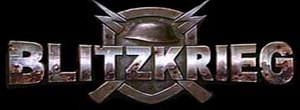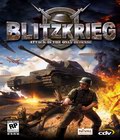Genre: WWII Strategy Simulation
Publisher: CDV
Developer: Nival Interactive
Date: May 12, 2003
Buy 'BLITZKRIEG': PC
At the peak of World War II, the Germans had the upper hand over the Allies, as they had begun utilizing the military tactics known as “Blitzkrieg” or “Lightning War.” This lightning war was the result of ambushes and quick overpowering battles in which the Germans out-manned the Allies and quickly crushed them. Unfortunately for the Germans, they lost the Battle of the Bulge, and in doing so ended up losing the war. If they had won, however, “Blitzkrieg” would have been the reason.
Nival Interactive, a developer that deals primarily in turn-based strategy games, decided to take on the task of making a strategy game based in World War II in which the player could choose from three different nations to play as (Russia, Germany, and United States). Their goal was to make an innovative title that could also visually astonish the gaming world. Sporting a sleek HUD (heads up display), the user plays the game in a “Top Down” format in which he looks down upon his troops. Each soldier, each tank, each plane, is a meticulously designed model, giving Blitzkrieg the very edge that it needed to succeed in its genre.
The game was a massive two gigabyte install that took quite a few minutes even on a 48x cd-rom, but then again, the bigger, the better. Once the game was installed and the video settings were optimized, game time was just around the corner. The first option in the main menu was the tutorial. Tutorials are key to the success of most games today, as people don’t have the time to spend three or four hours trying to learn how to play a game. The tutorial teaches you the game in about 30 minutes, which is great. Once the tutorial is complete, the player has the option to play in custom maps, multiplayer or the single player campaigns. The game sports three different single player campaigns, American, Soviet, and German, all of which feature their own unique unit types.
Each single player campaign features upwards of 20 missions, with each mission consisting of objectives ranging from destruction of key bridges to convoy escorts. The progression of each campaign follows the historical timeline of World War II. As the game progresses, technology advances, and so do the units. At the end of each mission, there is the ability to upgrade certain units from previous missions.
The technology utilized by Nival Interactive to control troop movement was one of, if not the most, revolutionary aspects of this game. With Nival’s game engine, the player can order his units into various formations, from marching to prone positions. The infantry can also be ordered to storm buildings that are occupied by enemy troops. In turn, the troops are also able to garrison buildings. Another key feature incorporated in the game is the troop’s ability to ambush other units by hiding in/behind/around trees and bushes.
Engineers play a crucial role in the progression of the game in both single and multiplayer modes. With engineers, the player is able to repair damaged vehicles and artillery, as well as dig trenches, build bridges, and setting and digging up landmines. The engineers are transported around in a small truck with low armor, making them very susceptible to being destroyed. A very closely related unit is the supply truck, which is important because it prevents units from running out of ammunition.
Armored attack vehicles in this game, such as tanks and half-tracks, are equipped with the ability to “dig in.” When used, this ability allows the tanks to surround themselves with sandbags or nearby dirt/sand, giving enemy units less to shoot at. This ability is best used when the player is defending against attack or in the process of attacking a city. When attacking, the player can “dig in” his vehicles and cut off the troops inside the city from reinforcements and prevent them from fleeing. It is a great way to put a stranglehold on one's opponent.
There are three types of artillery in Blitzkrieg, anti-aircraft, anti-tank, and anti-personnel. The majority of anti-aircraft and anti-personnel artillery is stationary and cannot be moved, aside from turning slightly. However, the anti-tank weapons and some machine guns are mobile via large transport trucks. Through these transport trucks, the player can move his infantry to any point on the map. Unfortunately, the trucks have very low armor and are very susceptible to being destroyed while heading towards a location.
The units in this game wouldn’t be complete without the aid of a handy sniper. The sniper, or “scout,” is great for reconnaissance and the elimination of small squads of troops. In most cases, when the scout is required for a mission, it is to take out a guard of some sort (i.e., a guard for a bridge) so that one's troops can pass over without being destroyed.
At its release, Blitzkrieg featured visuals in a strategy game that could only be matched by those of Command & Conquer: Generals. Nival expertly crafted vast ravaged landscapes for the detailed 3D tanks and troops to roll over and battle each other. Not only are the graphics amazing, but they run at high details even on lower-end machines, making this game playable on any machine that is faster than 1GHz. Through outstanding graphics/environments and strong scalability, Blitzkrieg has definitely been a visually pleasing game.


No World War II-based game would be complete without outstanding environmental sounds. It is great to be able to hear nearby shells going off, machine gun fire in the distance, all while the player moves his units up the map to meet their opponent. The explosions take full advantage of the bass on most sub woofers, making the game a real environmental experience. Included with the game is a classic soundtrack that sports music similar to that of Saving Private Ryan, and on certain maps, it certainly feels like you're in the movie.
With this game, multiplayer mode is just as important as the single player campaigns, if not more so. With different game modes like flag control and assault, along with the quite a few maps, the player is able to immerse himself in some multiplayer mayhem. The multiplayer here is very similar to that of games like Homeworld and Age of Empires; it has a similar battle style but lacks the ability to create structures. However, it is possible to utilize surrounding structures, fortify them, and then build barbed wire fences with landmines in such a way that enemies must pass by these fortified buildings, making them easy targets for nearby troops and hidden snipers. It is these cool features that make the multiplayer mode as impressive as it is.
 In the long run, Blitzkrieg lived up to its hyped potential. Nival produced a game that brought out all of the neat technology that was developed during World War II and put it at gamer’s fingertips. Crisply-detailed visuals, followed by a strong soundtrack and immensely addictive multiplayer mode make the game able to give C&C: Generals a run for its money. Unfortunately, Blitzkrieg failed to incorporate the ability to build structures, which would have made multiplayer that much more addictive, but then again, they can’t do everything. Blitzkrieg does a fine job of capturing the intensity of the battles of the great World War II.
In the long run, Blitzkrieg lived up to its hyped potential. Nival produced a game that brought out all of the neat technology that was developed during World War II and put it at gamer’s fingertips. Crisply-detailed visuals, followed by a strong soundtrack and immensely addictive multiplayer mode make the game able to give C&C: Generals a run for its money. Unfortunately, Blitzkrieg failed to incorporate the ability to build structures, which would have made multiplayer that much more addictive, but then again, they can’t do everything. Blitzkrieg does a fine job of capturing the intensity of the battles of the great World War II.
Score: 9 / 10
More articles about Blitzkrieg

















































